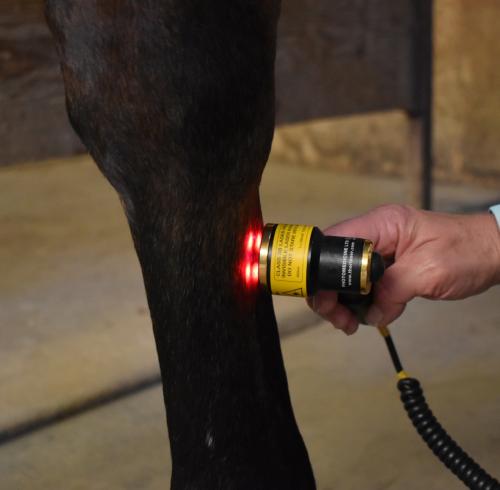Equine Rehabilitation
Electrotherapy

Electrotherapy, directing small currents of electricity through the skin for medical treatment, has been widely used in human sports medicine and rehabilitation to treat injuries and optimize performance. Various modalities have made their way into sport horse medicine and rehabilitation. Electrotherapies are built around energy sources that range from acoustics to vibrations.
Electrical Stimulation
Electrostimulation is commonly used for pain relief. Varying pulse durations and intensities mimic nerve patterns, causing muscles to contract. Transcutaneous electrical nerve stimulation (TENS) operates at 250 hertz(Hz), with the nerves closest to the surface of the skin activated first. Treatment occurs over 20-30 min, continuously or intermittently throughout the day. Use in humans is well researched, but evidence for use in horses is limited.
Neuromuscular electrical stimulation (NMES), commercially available as functional electrical stimulation (FES) units, is used to contract large muscles. Similar to TENS, it has longer pulse durations, variable amplitude and a frequency >50 Hz. Repetitions are increased over 3-5 weeks, with 1-5 sessions per week. One study reported that FES improved contraction and decreased muscle spasms in equine epaxial muscles, those located on the back directly under where the saddle sits (Schils et al. 2014).
Since these modalities involve placing electrodes on the skin, irritation can occur at the contact points if left on for too long. Minimal complications have been reported with proper use.
Electrotherapy is an evolving field. It is important to work with your veterinarian to determine the best course of treatment for your specific situation.
Magnetic Waves
Pulsed electromagnetic field therapy (PEMF) uses low-frequency magnetic waves to generate electrical currents in tissues. These units are found as blankets and wraps with built-in coils and batteries, with the size of the coil determining the size and strength of the magnetic field. Treatment protocols vary by manufacturer and side effects are rare. Research has not shown any significant soft tissue benefits for horses or humans. However, evidence suggests that the best application may be to bone healing, such as in cases of slow healing fractures (Schlacter and Lewis, 2016).
Sound and Pressure Waves
Therapeutic ultrasound uses vibration frequencies of 1-3 megahertz (MHz) to generate waves of acoustic energy (inaudible to humans) that can reach deep tissues, effectively a tissue micromassage. It is used for pain relief, to decrease muscle spasms, and to increase blood flow. Treatments occur daily for seven to ten days, can be pulsed or continuous, and may include the application of heat. Research has shown that equine tendons are effectively heated with therapeutic ultrasound, but heating of muscle has not been reported.
Extracorporeal shockwave therapy uses pressure waves that increase as they move through tissues. This results in microdamage caused by the generation and collapse of tiny air bubbles, leading to the formation of new blood vessels and increased blood flow. Protocols consist of 3-6 treatments at 2-3 week intervals to allow for proper healing of the microtrauma. Unlike therapeutic ultrasound, which can reach deep tissues, shockwaves only penetrate 50-110 mm. Studies have reported improved healing and reduced lameness in cases of front and hind limb sensory desmitis (Caminoto et al., 2005; McClure et al., 2004). Another study showed reduced lameness in horses with induced osteoarthritis, but no beneficial effects were identified in the synovial fluid, tissue, or cartilage of the affected joint. Since pain relief has been reported to last several days, masking a horse’s pain level, organizations such as the Fédération Équestre Internationale (FEI) have withdrawal time regulations prior to competition. Under California Horse Racing Board (CHRB) regulations, horses in California are unable to race or work until ten days after shockwave therapy.
Good skin contact is required as neither shockwaves nor ultrasound waves function through air. Patients must be clean, and clipped if possible. Gel is used to maximize contact.
Lasers
Laser therapy can reduce pain and inflammation. It has comparable benefits to acupuncture and is often used on similar trigger points. Low (power output <500 mW) and high (output >500 mW) power lasers have been used in horses. Daily, weekly, or monthly treatments of 5-30 minutes are performed based on the location and type of injury. Tissues can overheat if the therapy is not properly applied. Studies suggest that lasers are beneficial for tendon healing (Pluim et al. 2018). Research into the effects of laser therapy on wound healing is ongoing.
Vibration
Vibration plates create energy in an up-and-down or side-to-side direction, with amplitude and speed determining the magnitude of the vibration. Vibrations are thought to improve circulation through involuntary muscle contractions. Vibration plates may also promote joint stability by stimulating and strengthening associated muscles. Sessions are typically 10 to 15 minutes. To date, no undesirable effects have been reported. One study showed no changes in bone markers for horses that underwent vibration therapy (Carstanjen et al., 2013). However, maintenance of bone density was reported in stalled horses (Hulak et al. 2015) and muscle was increased (Halsberghe et al. 2016) in horses that underwent vibration therapy for 60 days. Whole body vibration therapy may also be beneficial for increasing hoof growth rate (Halsberghe 2018).
Electrotherapy is an evolving field. Although many applications are noninvasive, individual horses may not tolerate certain approaches. Many modalities are unregulated and, although research is ongoing, available peer-reviewed studies are minimal. It is important to work with your veterinarian to determine the best course of treatment for your specific situation.
